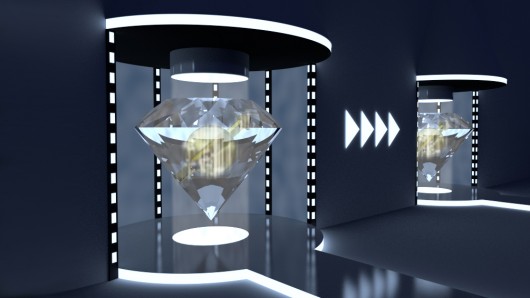
Researchers working at TU Delft's Kavli Institute of Nanoscience in the Netherlands claim to have successfully transferred data via teleportation. By exploiting the quantum phenomenon known as particle entanglement, the team says it transferred information across a 3 m (10 ft) distance, without the information actually traveling through the intervening space.
"Entanglement is arguably the strangest and most intriguing consequence of the laws of quantum mechanics," said the head of the research project, Professor Ronald Hanson. "When two particles become entangled, their identities merge: their collective state is precisely determined, but the individual identity of each of the particles has disappeared. The entangled particles behave as one, even when separated by a large distance." As electrons in an atom exist in orbits around a nucleus – like the way that the Earth spins on its axis – electrons also have "spin." When two electrons are entangled (that is, when they interact physically) and are then forcibly separated, the spin information on each becomes opposite to the other; they are essentially turned into mirror images. However – and this is the bit that Einstein found "creepy" in his rejection of the entanglement theory – when one of the entangled electrons has its spin direction changed by some means, the other electron immediately reverses its own spin direction. The distance in the Kavli Institute tests was 3 m (10 ft) but, theoretically, this distance could have been hundreds of light years. In this case, the team teleported information contained in one quantum bit (or qubit, the quantum analog of a standard computer bit) to a completely separate quantum bit, using specially-designed computer chips. Each chip featured a synthetic diamond to contain the entangled electrons and several nitrogen atoms. Data was then encoded for transmission in the transmitting diamond’s nitrogen atom as alterations of the spin of the electron. The electron in the receiver diamond then showed the opposite of that manipulation at precisely the time that the transmission was "sent." "We use diamonds because 'mini prisons' for electrons are formed in this material whenever a nitrogen atom is located in the position of one of the carbon atoms," explained Hanson. "The fact that we're able to view these miniature prisons individually makes it possible for us to study and verify an individual electron and even a single atomic nucleus. We're able to set the spin (rotational direction) of these particles in a predetermined state, verify this spin and subsequently read out the data." One practical upshot of this work is the idea of a future quantum network for communication – a quantum internet – between ultra-fast quantum computers. This should also enable completely secure information transfer, as eavesdropping will be fundamentally impossible in such a network because quantum mechanics guarantees that measuring quantum data affects that data, so any changes will be immediately recognized. In future experiments, the TU Delft team is planning on increasing the distance to more than 1,300 m (4,200 ft) with chips housed in several buildings across the university campus. The researchers hope to be the first to realize evidence to disprove Einstein’s rejection of the entanglement theory. Researchers working at TU Delft's Kavli Institute of Nanoscience in the Netherlands claim to have successfully transferred data via teleportation. By exploiting the quantum phenomenon known as particle entanglement, the team says it transferred information across a 3 m (10 ft) distance, without the information actually traveling through the intervening space.
Researchers working at TU Delft's Kavli Institute of Nanoscience in the Netherlands claim to have successfully transferred data via teleportation. By exploiting the quantum phenomenon known as particle entanglement, the team says it transferred information across a 3 m (10 ft) distance, without the information actually traveling through the intervening space.

 Previous page
Previous page Back to top
Back to top







